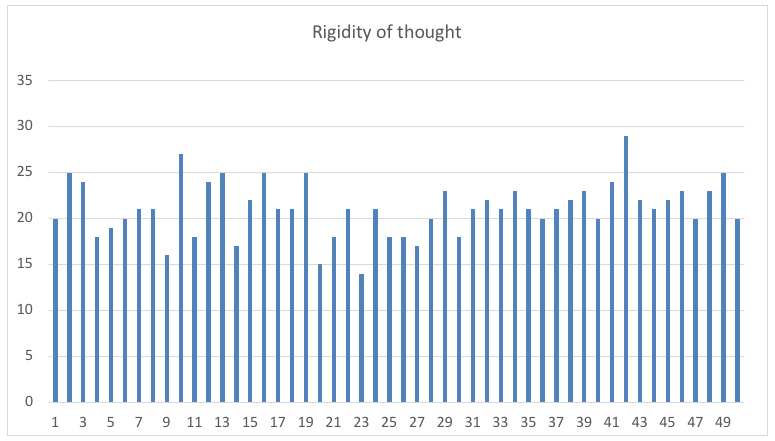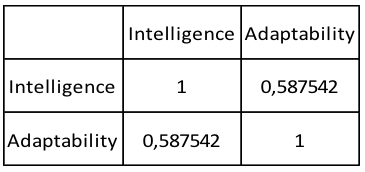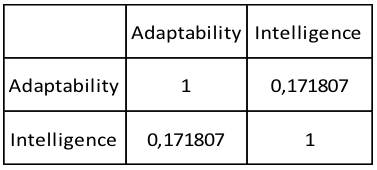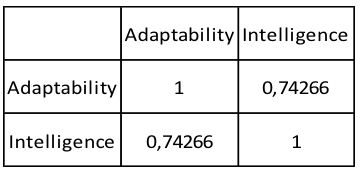

 Vol. 39 (# 05) Year 2018. Page 29
Vol. 39 (# 05) Year 2018. Page 29
Svetlana B. SERYAKOVA 1; Elena V. ZVONOVA 2; Valeriya V. SERYAKOVA 3
Received: 22/09/2017 • Approved: 18/10/2017
2. Methodology
3. Results
4. Conclusions
Acknowledgements
ABSTRACT: The modern world theory and practice of the organizational development shows transition from the paradigm of human resource management to the paradigm of potential development of employee that makes it possible in case of accountancy of personal characteristics of a person within the integrated interaction with organization. Career planning is considered as the process of active adaptation of an employee in the professional environment. The authors conclude that career planning of successful employees has signs of the steady informative strategy of design thinking, of stable characteristics of intellectual activity of a person in planning of vital prospects and solution of both crucial tasks. Active position of an employee, his/her desire and ability to operate the destiny is implemented within this strategy as one of the conditions of successful career. |
RESUMEN: La teoría moderna mundial y la práctica del desarrollo organizativo muestra el tránsito del paradigma del manejo de los recursos humanos al paradigma del desarrollo del potencial del empleado que sea posible teniendo en cuento las características personales en la interacción integrada con la empresa. La planificación de la carrera profesional está examinada como un proceso de la adaptación activa del empleado en el ambiente profesional. En el artículo está elаborada la suposición que la planificación de carrera de los empleados exitosos tiene los indicios de la estrategia informativaestable design thinking, las características estables de la actividad intelectual de la persona en la planificación de las perspectivas vitales y la decisión corriente, así como las tareas providenciales, en que se realiza la propia posición activa del empleado, su deseo y la capacidad de dirigir su destino. |
Contemporary education is closely connected with the idea of further development of the future professional and career planning (Armstrong M., 2004; Bebenina E.V. and Elkina I.M., 2017; Cujia S. E. et al., 2017; Flain A.L.G. and Richter M.G., 2016; Galustyan, O.V., 2015, 2017; Kirzner I.M., 1997; Petrash M.D., 2011; Romanello M., 2016). The company's career planning is a crucial step in the development of professional development which is associated with the implementation of a variety of professional positions, professional growth, and social status. This period is associated with the difficulties of growing up and entering the independent life, building one’s own lifestyle, there is the assimilation of educational and professional role (Bazarov T., 2011; Bohndick C. et al., 2017; Christensenk S., 2017; Grings J.A. and Jung C.F., 2016; Hunt J.M. et al., 2017; Shane S. and Venkataraman S., 2000; Schlee R.P. and Karns G.L., 2017). Nowadays there are a lot of investigated conditions of career planning, but the most productive approach is the study of the interaction between the employee and the organization as a complex phenomenon with different levels. The integral object of this study is to establish the process for mediating the properties and studying the indicators of changes in the process of mutual influence and interaction.
Studying human development in a professional environment (Merlin V. S., 2005) have proposed the dynamic structure of personality, which consisted of individual properties of the organism, system of individual mental properties, system of social and psychological individual characteristics (social roles played in the group and in the social and historical communities).The process of personality development is reflected in the increase of relations between properties belonging to different levels of the organization identity and the increase of ambiguity tendency of these relations.
While evaluating the external conditions of modern labor, it is necessary to consider the direction vector of the modern world theory and practice of management. The paradigm of human resources management (HRM) is gradually replaced by the conceptual positions of human development or talent management (TM) (Dunne D. and Martin R., 2006). Talent development and personal development are considered as the main condition for the very existence and prosperity of a modern organization and modern society in the contemporary business environment. Since personal development can be understood as the realization by the individual of his potential versatility, the infinity of evolution of human (Rubinstein S. L., 2003), the search for new methods and tools for employee development in organizations, career planning, self-management is one of the main directions of the innovative searches.
There are two groups of conditions determining the success of career planning. Personnel policy, characteristics of the external environment, values, management style and organizational culture in the company, skills development, etc. belong to the external conditions. Internal conditions are the level of adaptability, particularly organizational behavior, career orientations and attitudes, the ability to build a long-term time perspective (Rubinstein S. L., 2003).
However, the most important component performs its own activity of a person, his/her desire and ability to control his/her own destiny, which is the main condition that creates a systematic relationship between a person and organization and determine the capability and characteristics of his/her development. This activity is primarily manifested in design thinking, which is sustainable characteristics of intellectual activity in the planning life perspectives and addressing both current and fate tasks (Cruickshank L., 2010; Dalglish C.L. and Matthews J.H., 2011; Dubberly H., 2004; Dunne D. and Martin R., 2006).
The idea of design thinking came to the theory and practice of management of the professional design, where the main aim is to set style, methods, technologies, and tools in order to solve managerial and organizational problems (Fostering M.L., 2002; Ilipinar G. et al., 2008; Romme A.G.L., 2003). Currently, the most developed model of design thinking was implemented at Hasso Plattner Institute of Design at Stanford University and School of Entrepreneurial Design Thinking in Koblenz, Germany.
Design thinking is the procedural structure of thinking which generates an aesthetic image and which can be realized in forms, configurations, and compositions of functional models and the ways of actions. Initially, design thinking ("the habit of thinking") focused on the creation of psychological conditions for the new solutions of processes, services or organizational changes (Cruickshank L., 2010; Dalglish C.L. and Matthews J.H., 2011; Dubberly H., 2004; Dunne D. and Martin R., 2006). Design thinking is considered as productive and promising technology in creating the psychological conditions for self-development, career planning and self-management.
Psychological conditions for successful career planning are personal characteristics of an employee that are in dynamic relationships. There is a medium and high levels of adaptability, creative thinking, medium and high levels of intelligence. Social and organizational conditions of career planning are system work for the development of staff such as prospects, personal reserve, training that focus on staff development, psychological training for adaptation and motivation of personnel (Fostering M.L., 2002; Ilipinar G. et al., 2008; Romme A.G.L., 2003).
Characteristics of career planning have features of design thinking, which allow to take into account the advantage of opportunities for career advancement and to create a plan of development by finding innovative solutions.
The experimental group was formed from the employees of different specialties (computer programmers, economists, psychologists, doctors, biologists, lawyers, educators, and teachers), working in different organizations (commercial and governmental), and occupying different positions and organizational status. There were the following characteristics for the inclusion of the participants in the study such as age of 20-32, higher education, working experience of more than one year.
The entry questionnaire contained questions that helped to get important research data (adaptation at new working place, prospects of the position, career planning, and design thinking).
The next step was the diagnosis of psychological characteristics of members of the group using technique “Adaptability“, which has been adapted by Maklakov A. G. and Chermyanin S. V. (Maklakov A.G., Chermyanin S.V., 2001). This technique allowed determining the adaptability of the volunteers. Social and psychological characteristics of the participants were also taken into account. We obtained the following results. The participants were divided into groups. The first group was of low level of adaptability (1-3 points, 12, 24% of the total group). The second group was of medium level of adaptability (4-8 points, 37, 74% of the total group). The group of high level of adaptability included only 1 person (9 points, 2% of the total group).
We conducted Wechsler Adult Intelligence Scale (WAIS), which meant for testing adults from 16 to 64 years of age according to the research plan (Karelin A.A., 2007). The test results were divided into 3 groups. The number of the participants of low level of intelligence was 8 (16 % of the total group). The number of the participants of medium level of intelligence was 33 people (66 % of the total group). The number of the participants of high level of intelligence was 9 people (18% of the total group).
We have obtained the following data. 49 of 50 participants belong to the group of people who exhibit the traits of rigidity and mobility. People of moderate level of rigidity are sufficiently "agile", they know what they want, they have already developed schemes of behaviors, and they know how to act in certain situations. They rarely have troubles with adaptation in different situations; they don’t have any problem with interacting with the other people. Only one participant showed a high level of rigidity, he also showed a low level of adaptability.
Figure 1
The level of rigidity of thinking

The obtained data allowed to conduct statistical analysis and to calculate the correlation between the level of adaptability and level of intelligence.
The rank of correlation between the indices of adaptability and the level of intelligence and rigidity were calculated using the Spearman rank correlation (Nasledov A.D.,2004). We used the program STATISTIKA. The level of significance within the program STATISTICA showed <0,05, that allowed 5 of 100 incorrect indices. The results are reflected in Table 1.
Table 1
Correlation data of the results

Spearman rank correlation is 0.506, consequently, the correlation between intelligence and adaptability of the specified group significantly differs from zero (is not random) on the level of statistical significance (at p ≤ 0.05).
Based on the analysis of data correlation between the level of adaptability ( -0,036) and intelligence ( -0,246), we can conclude that there is no correlation at our level of significance.
Next, we conducted a qualitative analysis of the groups having, respectively, according to the Wechsler Adult Intelligence Scale (WAIS), different levels of intelligence.
The group with the low level of intelligence consisted 8 people (economists, PR specialists, psychologists, and physicians). During the interview, it was revealed, that 4 people estimated the duration of their adaptation period for 3 months; 3 persons estimated this period for 2 months, and one person considered that adaptation period should take only one week.
When filling in the questionnaire, 6 from 8 participants said, that they didn’t see any prospects for the current working place and wanted to change it. Two of the participants answered that there was a possibility of horizontal growth and the employee might occupy the position of leader, but they were not sure if they would succeed. All the members of the group responded that they had not been involved in the career planning for a long time because they believed that everything couldn’t be predicted and foreseen.
Statistical analysis of the level of intelligence and adaptability is revealed in Table 2.
Table 2
Correlation of low level of
intelligence and adaptability

The group of employees who showed the medium level of intelligence, included 33 persons, mostly representatives of the "humanitarian" professions (psychologists, biologists, pedagogues, teachers, lawyers, a large part of health professionals, and economists).
This group indicated different results. They needed for adaptation from 2 weeks to 3 months. As for the possible prospects at the working place, 72% of the participants of the total group of the medium level of intelligence noted that perspectives at the current job were possible, but they didn’t have good education, excellent knowledge and skills, they needed a happy coincidence, or just luck. One person of all the participants noted that the possibility of good prospects in the working place might depend on the external social relations, namely, friends or relatives could help them to get a job and then to help with the career development. All the members of the group noted that they planned their future for the next foreseeable period, but they considered that things could change, so there was no use in constructing long-term plans. 24 people indicated that they had a negative experience of planning, that when entering the university, they dreamed of professional growth, however, in the recent years the situation had changed so much that dreams had not come true.
Table 3
Correlation of medium intelligence
and adaptability

Indicators 0,171807 reveal that the dependence is small, and since the significance level of 0.05, we should conclude that the indicators are below normal.
The group with a high level of intelligence included 9 people, representatives of technical professions (IT specialists), medics, biologists, and psychologists.
Correlation coefficient is 0,742660 as a result of the correlation analysis between the indicators of the level of intelligence and adaptability.
Table 4
The correlation of high level of
intelligence and adaptability.

Qualitative analysis of data showed that 66% percent of the participants remarked, that they needed 2 weeks for adaptation, and there was a high probability and possibility of professional and career growth at the current working place. They also noted that it was always possible to find prospect, this would depend on a person, his/her efforts, his/her desire and demonstration of special qualities. Employees had an idea about the career planning and understood how to achieve success in their profession.
The results of qualitative analysis showed that the participants with high level of intelligence had also an adequate level of adaptability and they understood what career planning meant and how they could successfully implement it.
The results of the study showed that the participants started the planning process with the building of an emotionally attractive vision of the future, its detailing, and then there was an active mental search for the identification of the image of a possible statement of purpose. The stage of generating ideas was one of the principal ones. The main task was to generate as many ideas as possible because many ideas showed great possibility. The participants began a process of improvement of all ideas, when they evaluated the best ideas from the point of view of the personal acceptance and conformity of their own views about themselves. Evaluation of the planning result didn’t lead to the abandonment of career plans, but to using of the additional resources. They built personal and emotional career plan that included several variants, oriented on favorable and unfavorable external conditions.
Summing up, it should be noted that the adaptability and high-level indicators of intelligence are the psychological terms of career planning. External circumstances help or hinder career planning due to the perspective of assessment of the capabilities and the prospects of the employees. Employees of high level of adaptability and high level of intelligence take into account the external conditions in planning their own life and job.
This work was supported by grant No.16-06-00908 "Social and pedagogical competence of an expert of the social sphere".
ARMSTRONG M. (2004). Practice of Human Resource Control, Piter, 832.
BAZAROV T. (2011). Survey of Personnel as an Instrument of Internal Control. Internal Control in Credit Institution, 2 (10), 79-92.
BEBENINA E.V., ELKINA I.M. (2017). University Ranking as a Tool for the Formation of Educational Space. Revista Espacios, 38(40), 6. Retrieved from http://www.revistaespacios.com/a17v38n40/17384006.html
BOHNDICK C., KOHLMEYER S., BUHL, H.M. (2017). Competencies and Career Choice Motives: Characteristics of High School Students Interested in Teacher Education Programmes. Journal of Education for Teaching,1-15.
CRUICKSHANK L. (2010). The Innovation Dimension: Designing in a Broader Context. Spring, 26(2), 17–26.
CHRISTENSENK S. (2017). A Career in Planning. Journal of the American Planning Association, 83 (3), 315-321.
CUJIA S. E., MARTELO, R. J., JIMENEZ-PITRE I. (2017). Modelo Teórico-Metodológico Para la Aplicación de Lastecnologías de Información y Comunicación en el Contexto Universitario. Revista Espacios, 38(30), 2. Retrieved fromhttp://www.revistaespacios.com/a17v38n30/17383002.html
DALGLISH C.L., MATTHEWS J.H. (2011). Positive Design and Construction of Mechanisms for the Sustainable Development in Microenterprises in Africa. Emerald Group Publishing Inc., 297–317.
DUBBERLY H. (2004). How Do You Design? A Compendium of Models. San Francisco: Dubberly Design Office.
DUNNE D., MARTIN R. (2006). Design Thinking and How It will Change Management Education: an Interview and Discussion. Academy of Management Learning and Education, 5(4), 512–523.
FLAIN A.L.G., RICHTER M.G. (2016). A Profissionalização Docente e a Resiliência Como Fatores de Redução de Complexidade no Sistema de Ensino.
Revista Espacios, 38(15), 3. Retrieved from http://www.revistaespacios.com/a17v38n15/17381503.html
FOSTERING M.L. (2002). Design Culture Through Cultivating the User-Designers’ Design Thinking and Systems Thinking. Systemic Practice and Action Research, 15(5), 385–410.
GALUSTYAN O.V. (2015). Digital Campus as Electronic Image of the University. Rupkatha Journal on Interdisciplinary Studies in Humanities, 7(3), 263-270.Retrieved from http://rupkatha.com/V7/n3/28_digital-campus.pdf
GALUSTYAN O.V. (2017). Some Methodological Aspects of the Evaluation of Students’ Educational Achievements at University. (IJCRSEE) International Journal of Cognitive Research in Science, Engineering and Education, 5(1), 43-48. Retrieved from http://www.ijcrsee.com/index.php/IJCRSEE/article/view/7/9
GRINGS J.A., JUNG C.F. (2016). Fatores que Influenciam Naescolha Profissional e a Importância da Orientação Vocacional e Ocupacional. RevistaEspacios, 38(15), 12. Retrieved from http://www.revistaespacios.com/a17v38n15/17381512.html
HUNT J.M., LANGOWITZ N., ROLLAG K., HEBERT-MACCARO, K. (2017). Helping Students Make Progress in Their Careers: An Attribute Analysis of Effective vs Ineffective Student Development plans. International Journal of Management Education, 15 (3), 397-408.
ILIPINAR G., JOHNSTON W. J. MONTANA J., SPENDER J.C. (2008). Design Thinking in the Postmodern Organization, Business Review, 10 (11), 1203-1212.
KARELIN A.A. Encyclopedia of Psychological Tests. Eksmo, 2007. 416. (In Russ.).
KIRZNER I.M. (1997). Entrepreneurial Discovery and the Competitive Market Process: An Austrian Approach. Journal of Economic Literature,35(1), 60–85.
MAKLAKOV A.G., CHERMYANIN S.V. (2001). Multilevel Personal Questionnaire "Adaptability". Practical Psychodiagnostics, 549-558. (In Russ.).
MERLIN V.S. (2005). Identity Psychology: Chosen Psychological Works. MODEK, 253.
(In Russ.).
NASLEDOV A.D. (2004). Mathematical Methods of a Psychological Study. Rech, 235-388. (In Russ.)
PETRASH M.D. (2011). Psychological Contents and Factors of Emergence of Professional
Development Crises at the Stage of the Professional Activity. Experimental Psychology,
4(4), 88-100. (In Russ.)
ROMANELLO M. (2016). The Private and Social Return to Education Considering the Characteristics of Society. Revista Espacios, 38(15), 13. Retrieved from http://www.revistaespacios.com/a17v38n15/17381513.html
ROMME A.G.L. (2003). Making a Difference: Organization as Design. Organization Science, 14(5), 558–573.
RUBINSTEIN S. L. (2003). Life and Consciousness. A Person and the World, 508. (In Russ.).
SHANE S., VENKATARAMAN S. (2000). The Promise of Entrepreneurship as a Field of Research. Academy of Management Review, 25, 217–226.
SCHLEE R.P., KARNS G.L. (2017). Job Requirements for Marketing Graduates: Are There Differences in the Knowledge, Skills, and Personal Attributes Needed for Different Salary Levels? Journal of Marketing Education, 39 (2),69-81.
1. Moscow State Pedagogical University, Moscow, Russia. E-mail: svetlana.b.seryakova@gmail.com
2. Moscow State Pedagogical University, Moscow, Russia.
3. Moscow State Pedagogical University, Moscow, Russia.